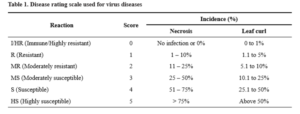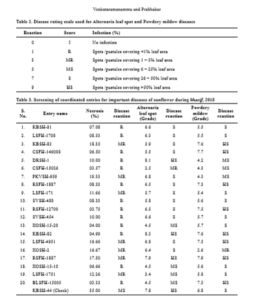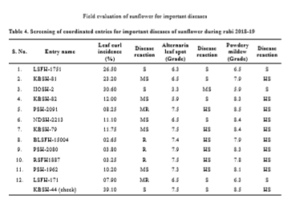FIELD EVALUATION OF COORDINATED ENTRIES OF SUNFLOWER FOR IMPORTANT DISEASES
0 Views
K.VENKATARAMANAMMA* AND K. PRABHAKAR
Regional Agricultural Research Station, ANGRAU, Nandyal – 518 502, Kurnool Dt., A.P.
ABSTRACT
A total of 32 coordinated entries of sunflower screened in Kharif and rabi seasons of 2018-19 for important diseases of sunflower like necrosis, leaf curl, Alternaria leaf spot and powdery mildew under field conditions. Susceptible check KBSH-44 was sown after every two rows of entries. It was found that, among the 20 entries screened, 13 entries were resistant to necrosis, CSFH-146008 was moderately resistant to Alternaria leaf spot and IIOSH-2 for powdery mildew diseases during kharif season. During rabi, three lines were found as resistant to leaf curl, one entry was moderately susceptible, five entries were susceptible and six entries were highly susceptible to Alternaria leaf spot. For powdery mildew disease, three entries were susceptible and nine entries were highly susceptible. Out of all the entries, for kharif, only one entry each showed moderately resistant reaction to Alternaria leaf spot and powdery mildew diseases. These resistant or moderately resistant entries may be used in severe disease prone areas to reduce losses to sunflower crop.
KEYWORDS:
Alternaria, necrosis, leaf curl, powdery mildew, sunflower, screening
INTRODUCTION
Sunflower is one of the important oilseed crop grown in India, being cropped in an area of 2.47 lakh ha in 201819, having a production and productivity of 2.19 lakh tonn and 886 kg ha-1 (Directors report, 2019-20) there of respectively. In recent years, the cropped area was reduced drastically, owing to many reasons. Major diseases like necrosis, leaf curl, Alternaria leaf spot and powdery mildew were observed on sunflower are few major reasons worth mentioning. Among virus diseases, leaf curl is one of the serious disease reported in India in recent years (Govindappa et al., 2011) apart from necrosis, belongs to Begomo virus group and infecting many crops. Necrosis is also causing substantial yield losses ranged from 30 to 90 percent in most of the sunflower growing regions of Andhra Pradesh, Karnataka and Maharashtra (Rao et al., 2002). Among Fungal diseases, Alternaria leaf spot and powdery mildew are major foliar diseases, affecting the crop cultivation. Though different methods are available for management of diseases, host plant resistance plays a major role as it is safe and environmentally friendly. Keeping the above points in view, screening or evaluation of different entries against diseases was performed under field conditions.
MATERIAL AND METHODS
This experiment was carried out at RARS, Nandyal farm under All India Co-ordinated Research Project (AICRP) on sunflower scheme. Twenty entries during kharif 2018 and twelve entries during rabi 2018-19 were screened for major diseases of sunflower such as necrosis, Alternaria leaf spot, powdery mildew and leaf curl diseases. Among them, five entries were commonly . These entries were received from Indian Institute of Oilseed Research (IIOR), Hyderabad. The experiment was carried out in RBD design with two replications. Each entry was sown in two rows and each row is of 4.5M in length. For every two rows, one line of susceptible check (KBSH-44) was sown. It is susceptible to all diseases of sunflower for which screening was done.
Experimental filed was bordered with Parthenium plants, as Parthenium pollen was source of necrosis virus, the disease pressure may be increased. Data on different diseases was recorded when the susceptible check is showing more than 50% of disease or during flowering stage.
Following formulae were adopted in assessing crop’s reaction to different disease severities
Field evaluation of sunflower for important diseases
Necrosis and leaf curl incidence was calculated by using the following formula.

Different entries were placed into different disease reaction categories, using disease rating scale of 0-5 scale for both necrosis (Anonymous, 2014-15) and leaf curl (Sunkad, 2002) diseases (Table 1).
Ten plants in each entry were randomly selected for observation of both foliar diseases i.e., Alternaria leaf spot and powdery mildew diseases when the susceptible check was recorded more than 50% disease severity by using 0-9 scale (Table 2). Averages of disease infection score were taken and placed the entries into different disease reaction categories.
RESULTS AND DISCUSSION
During kharif 2018, 20 entries were screened for necrosis, Alternaria leaf spot and powdery mildew diseases. Twelve entries such as KBSH-81, LSFH-1708, CSFH-146008, DRSH-1, CSFH-15026, RSFH-1887, SVSH-488, RSFH-12700, SVSH-454, IIOSH-15-20, KBSH-82, IIOSH-15-10 and BLSFH-15005 were recorded as resistant, seven entries were moderately resistant to necrosis and the check was recorded as susceptible (Table 3) reaction among them. For Alternaria leaf spot, among different entries the entry KBSH-82 was recorded maximum severity for Alternaria leaf spot and RSFH-1887 showed maximum severity for powdery mildew disease. For Alternaria leaf spot disease, only one entry i.e., CSFH-146008 was recorded as moderately resistant, four were moderately susceptible, 12 were susceptible and three lines were highly susceptible. Only one entry i.e., IIOSH-2 was reported as moderately resistant, three lines were moderately susceptible, eight entries were susceptible and eight entries were highly susceptible to powdery mildew disease.
During rabi, 2018-19, for leaf curl disease, three entries were recorded as resistant BLSFH-15004, PSH2080 and RSFH1887, two entries were recorded as moderately resistant, five entries were recorded as moderately susceptible and two entries were recorded as susceptible(Table 4). No entry has shown resistant reaction for the three fungal diseases. For Alternaria leaf spot disease, one entry (IIOSH-2) showed moderately susceptible, five entries were susceptible and six entries were highly susceptible in nature. For powdery mildew disease, three entries were susceptible and nine entries were highly susceptible in nature. The check entry was found susceptible to leaf curl, Alternaria leaf spot and Highly susceptible to powdery mildew disease.
Five entries such as KBSH-81, IIOSH-2, KBSH-82, RSFH-1887 and LSFH-171 were screened in both the seasons and found that during kharif, for Alternaria leaf spot, three entries such as KBSH-81, RSFH-1887 and LSFH-171 showed susceptible reaction and one entry KBSH-82 showed highly susceptible reaction to Alternaria leaf spot. For powdery mildew disease in both seasons, three entries showed same reaction i.e., KBSH-



82, RSFH-1887 recorded highly susceptible and LSFH171 showed susceptible reaction.
Similar works were carried out in sunflower by Karuna et al.(2014) who screened 100 germplasm lines and 50 coordinated entries for Alternaria leaf spot disease under natural conditions and found that among germplasm lines, 78 lines are moderately resistant and four lines were susceptible and among entries, only one entry has shown resistant reaction. Similarly, kolte (1990), Dudhe and Bharsakle (2005) screened 100 germplasm lines for powdery mildew disease and found that 59 germplasm lines were moderately resistant, 27 were moderately susceptible, three were resistant, six were susceptible, one was immune and two were highly susceptible. Venkataramanamma et al. (2016 ) also screened one hundred germplasm lines each consecutively for two years i.e., during 2011 and 2012 for Alternaria leaf spot and powdery mildew diseases and found 8 lines were resistant both to Alternaria leaf spot and powdery mildew diseases during 2011 and during 2012 one line is resistant and 64 lines were moderately resistant to Alternaria leaf spot and GMU-1004 was found free from powdery mildew disease and three lines were resistant.
It was found that during kharif, 13 entries were resistant to necrosis, one entry each was moderately resistant (CSFH-146008) to Alternaria leaf spot and powdery mildew (IIOSH-2) diseases. During rabi 201819, three lines were found as resistant to leaf curl and further these results has to be confirmed with screening data under artificial conditions. If the resistance was confirmed under artificial conditions, the same may be useful for resistance breeding.
LITERATURE CITED
Rao, S.C., Raoof, M.A and Singh, H. 2000. Sunflower necrosis disease: a preliminary study on transmission. In: Proceedings of extended summaries 2000. National seminar on oilseeds and Oilseeds Research Development needs in the 3rd millennium. Indian Soc. Of oilseeds Research (DOR). Hyderabad. Februay 2-4. 285-286.
Directors report, 2019-20. All India Coordinated Research Project on Oilseeds (Sunflower &Castor). ICARIIOR. Rajendranagar, Hyderabad. 30.
Dudhe, M.Y and Bharsakle. 2005. Screening of germplasm lines for resistance to Alternaria blight and necrosis disease in sunflower. Crop Protection. 1(2): 84.
Kolte, S.J. 1990. Diseases of Annual Oilseed Crops vol III P 40, CRC press Inc., Boca Raton, Florida.
Govindappa, M.R., Shankergoud, I., Shankarappa, K.S., Wickramaarachchi, W.A.R.T., Reddy, B.A and Rangaswamy, K.T. 2011. Molecular and partial characterization Begomovirus associated with leaf curl disease of sunflower (Helianthus annveus) in southern India. Plant Pathology Journal. 10: 29-35.
Sunkad,G., Kenchanagoudar, P.V and Vijayakumar, S. 2002. Management of peanut bud necrosis disease of groundnut using leaf extracts. Karnataka Journal of Agricultural Sciences. 15(4): 649-652.
Karuna, K., Nagaraju, Y., Shadakshari, G and Geetha, K.N. 2014. Screening of sunflower genotypes for resistance against Alternaria helianthi (Hansf.) Tubaki and Nishihara causing leaf blight. Bioinfolet. 11(4a): 990-994.
Venkataramanamma, K., Madhusudhan, P., Neelima S., Kumar, K.A and Reddy, K.V.V. 2016. Screening of sunflower germplasm for Alternaria leaf spot and powdery mildew diseases under field conditions. Bioinfolet. 13(3): 460-463.
- Bio-Formulations for Plant Growth-Promoting Streptomyces SP.
- Brand Preference of Farmers for Maize Seed
- Issues That Consumer Experience Towards Online Food Delivery (Ofd) Services in Tirupati City
- Influence of High Density Planting on Yield Parameters of Super Early and Mid Early Varieties of Redgram (Cajanus Cajan (L.) Millsp.)
- Influence of Iron, Zinc and Supplemental N P K on Yield and Yield Attributes of Dry Direct Sown Rice
- Effect of Soil and Foliar Application of Nutrients on the Performance of Bold Seeded Groundnut (Arachis Hypogaea L.)

